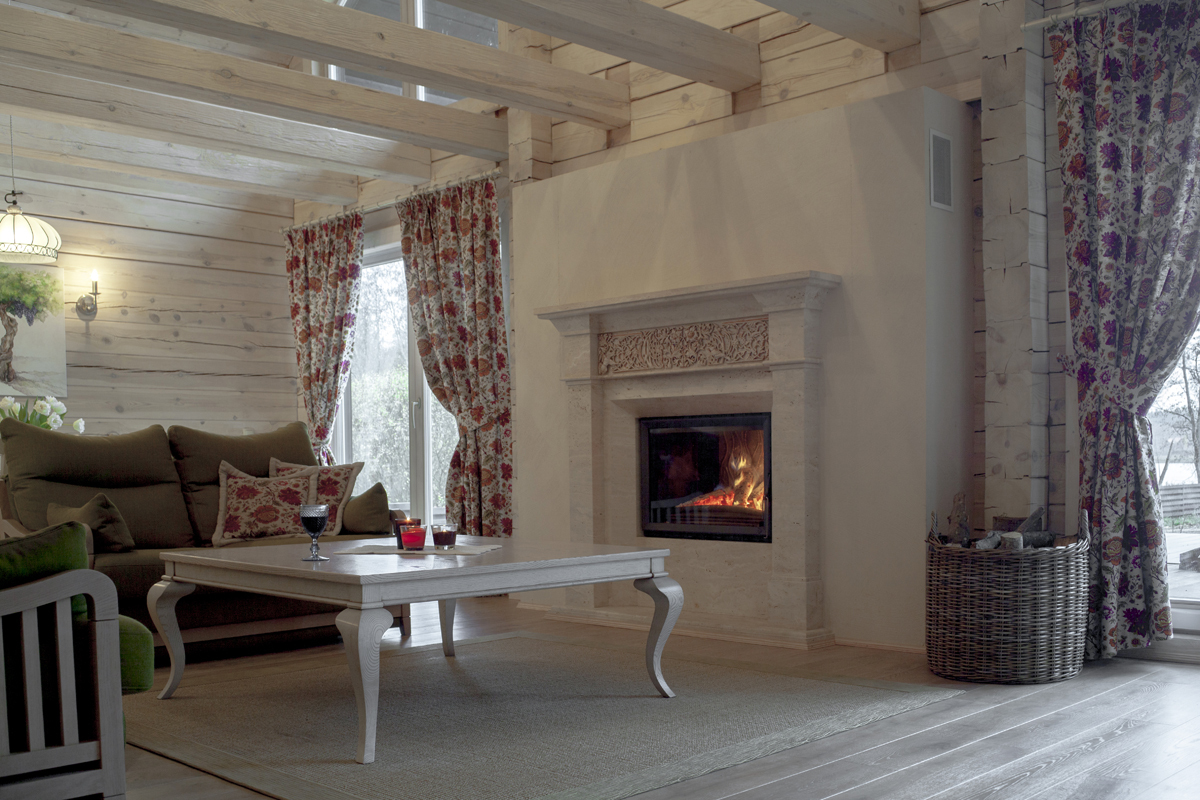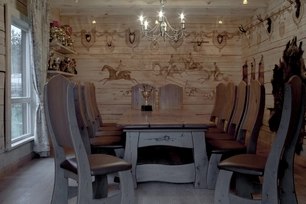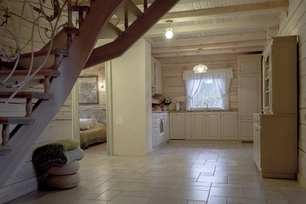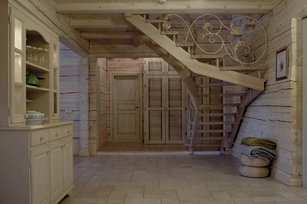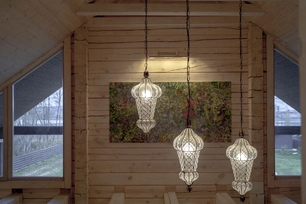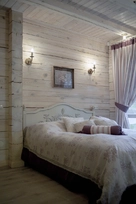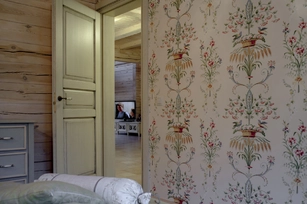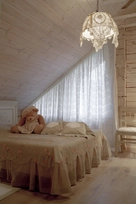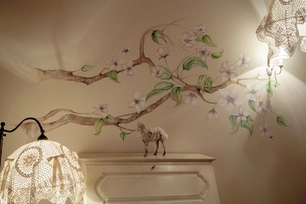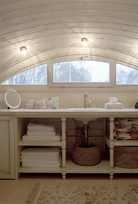Apie projektą:
Šalis: Lietuva
Plotas: 200 m2
Namelis ant ežero kranto
Provansas – tai Pietryčių Prancūzijos regionas, kurio kerinčią architektūrą, gyvenimo kultūros tradicijas atranda vis daugiau ir mūsų krašto žmonių. Šio rąstinio namelio ant Bebrusų ežero kranto interjeras yra sukurtas provanso stiliaus dvasia, perteikiant jaukumą ir natūralumą. Šio stiliaus išskirtinumas, kad namai puošiami žvelgiant į senovę, o ne dairantis į ateities tendencijas. Šiuose namuose baldai ir daiktai nėra seni, tačiau visi jie pagaminti savo darbą išmanančių ir gerą energiją spinduliuojančią meistrų rankomis. Natūralaus medžio baldai yra puošti raižiniais ir ornamentais, apdirbti naudojant specialią sendinimo techniką, yra tarsi liudijimas, kad rankų darbo tradicijas verta saugoti ir branginti. Itališki „Siru“ kompanijos šviestuvai taip pat gaminami meistrų, o ne mašinų, todėl išgaunama stiklo faktūra nesikeičia šimtmečiais. Kiekvienam kambariui sukūriau skirtingų spalvų ir kirpimo linines užuolaidas ir lovatieses, jas derinant prie augalinio motyvo tapetų. Visa tai suteikia interjerui švelnios nostalgijos. Židiniui skirta ypatinga vieta, kad šildytų namus ir kitoje sienos pusėje esančioje krosnyje būtų galima gaminti maistą. Akmuo – travertinas, keramikinis dekoras – Beatos Janulienės darbas. Medžioklės kambariui išskirtinumo suteikia tapybos darbas ant sienos, kuriame pavaizduota medžioklės scena Prancūzijoje. Sienos tapyba – dalininko Laisvio Janulio darbas. Įkalbėjau šeimininkus išsaugoti erdvę virš svetainės, balkiai yra ne tik atramos, bet ir interjero detalės. Erdvę virš balkių puošia dailininkės Nomedos Saukienės tapybos darbas. Sultingas vynuoges nutapė dailininkė Donata Porvaneckaitė. Nuostabus kalvio Egidijaus Lukšio darbas puošia laiptus. Obels šaka, nutapyta vaikų kambaryje ant sienos – mano darbas. Tos pačios namų puošybos taisyklės galioja tiek Prancūzijoje, tiek ir Lietuvoje. Svarbiausia noras gyventi gražiai ir jaukiai.
This is a luxurious and elegant A class house of 550 sq.m. Interior style - modern classical style. I am gladthat I had the opportunity to start working with architect Arūnas Pliuskumifrom the very beginning of the house design and project stages. This made itpossible to make the best solutions for interior design.
High ceilings, pastel colours, gypsum decorations on the walls and ceilings make a great impression of space.The indoor doors of the house are designed specifically for this project, witha height of 2.80 m. and 2.40 m, carvings covered with gold touches. The door-to-walldoorway between the living room and the kitchen is the perfect solution toseparate these two spaces whenever desired. The hallway is naturally expandedby a huge mirror, elegant, upstairs light stairs, and metal railings that wereblown by Lithuanian blacksmiths.
Most of the indoor lamps were produced on the island of Murano in Italy, LED lighting is used as the main lightsource, but is invisible at the same time.
As requested by the owners, therooms of 3 children had to be similar and different at the same time. Thus, wehave picked the wallpaper of same texture and ornaments, just with different colours.Bed shapes are the same in all the children rooms, however, their décor differs.
Most of the furniture is uniquely created and crafted for this project and produced by Lithuanian manufacturers.
The height of the ceiling of the hunting room of the owner is up to 6 meters. Huge wooden columns along theceiling, allows the owner to exhibit a great deal of hunting trophies. The mainaccents of the room – hunting trophies are well visible due to light-reflectingwallpaper and wooden panels on the walls.
The Degrade technique of laying down the tiles was used in the swimming pool area. The Degrade techniquemeans that the tiles are laid down from the darkest to the lightest shade, deepeningthe pool area visually and raising the ceiling of the steam room at the sametime.
The clinker and the wood materials were used for the decoration of the wine cellar room, and hand-made glass vases were used for lighting.
Lots of interior details, paintings, and other works of art that make this interior unique, were createdby Lithuanian artists. Stained glass at the entrance (vitražas) was created byLaura Karčiauskaitė-Potet, the fireplace was created by sculptor Jonas Gelčys,the detail of the fireplace decoration – the work of Beatas Janulienė.
Nuotraukos: Tania Serket
© 2025 visos teisės saugomos
Norėdami išsaugoti, prisijunkite.
Siekdami užtikrinti geriausią Jūsų naršymo patirtį, šiame portale naudojame slapukus.
Daugiau informacijos ir pasirinkimo galimybių rasite paspaudus mygtuką „Nustatymai“.
Jei ateityje norėsite pakeisti šį leidimą, tą galėsite bet kada galėsite padaryti paspaudžiant portalo apačioje esančią „Slapukų nustatymai“ nuorodą.
Tai portalo veikimui būtini slapukai, kurie yra įjungti visada. Šių slapukų naudojimą galima išjungti tik pakeitus naršyklės nuostatas.
| Pavadinimas | Aprašymas | Galiojimo laikas |
|---|---|---|
| storage_consent | Šiame slapuke išsaugoma informacija, kurias šiuose nustatymuose matomų slapukų grupes leidžiate naudoti. | 365 dienos |
| PHPSESSID | Sesijos identifikacinis numeris, reikalingas bazinių portalo funkcijų (pavyzdžiui, galimybei prisijungti, užildyti užklausos formą ir kitų) veikimo užtrikinimui. | Iki naršyklės uždarymo |
| REMEMBERME | Prisijungimui prie asmeninės paskyros portale naudojamas slapukas. | 1 mėnuo |
| OAID | Portalo vidinės reklaminių skydelių valdymo sistemos slapukas. | 1 metai |
| __eoi | Saugumo paskirtį atliekantis Google paslaugose (Google AdSense, AdSense for Search, Display & Video 360, Google Ad Manager, Google Ads) naudojamas slapukas. | 6 mėnesiai |
| sender_popup_shown_* | Naujienlaiškio užsakymo formos nustatymai. | 1 mėnuo |
Slapukai skirti informacijos apie portalo lankomumą rinkimui.
| Pavadinimas | Aprašymas | Galiojimo laikas |
|---|---|---|
| _ga | Google Analytics statistikos slapukas | 2 metai |
| _ga_* | Google Analytics statistikos slapukas | 2 metai |
Rinkodaros arba reklamos slapukai, kurie naudojami siekiant parodyti pasiūlymus ar kitą informaciją, kuri galėtų Jus sudominti.
| Pavadinimas | Aprašymas | Galiojimo laikas |
|---|---|---|
| test_cookie | Naudojamas Google paslaugose (Google AdSense, AdSense for Search, Display & Video 360, Google Ad Manager, Google Ads). | 15 minučių |
| __Secure-3PAPISID | Naudojama Google paslaugose vartotojo nustatymų ir informacijos saugojimui. | 13 mėnesių |
| __Secure-3PSID | Naudojama Google paslaugose vartotojo nustatymų ir informacijos saugojimui. | 13 mėnesių |
| _fbp | Facebook platformos slapukas. | 90 dienų |
| _fbc | Facebook platformos slapukas. | 90 dienų |
| datr | Facebook platformos slapukas. | 1 metai |

